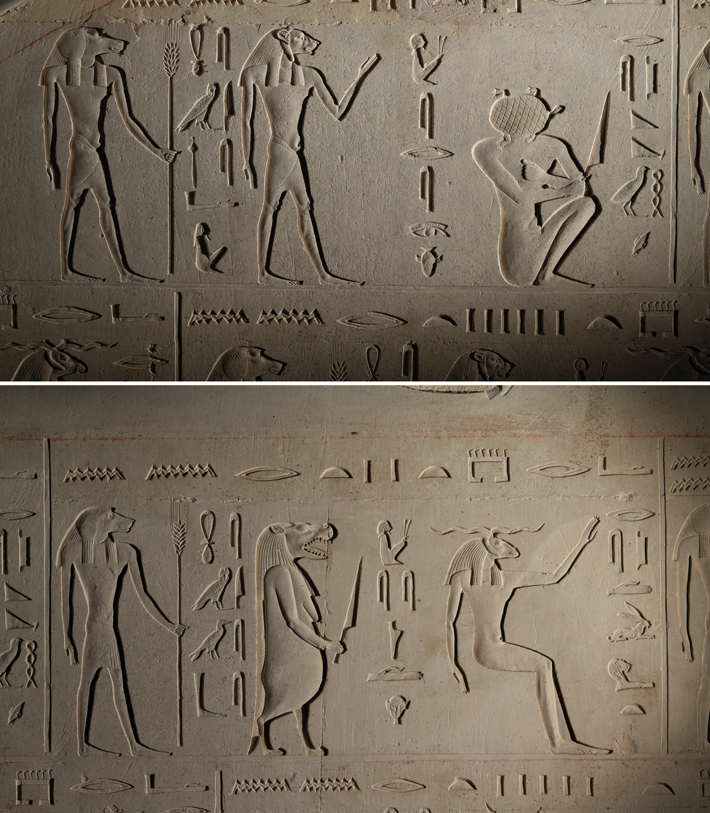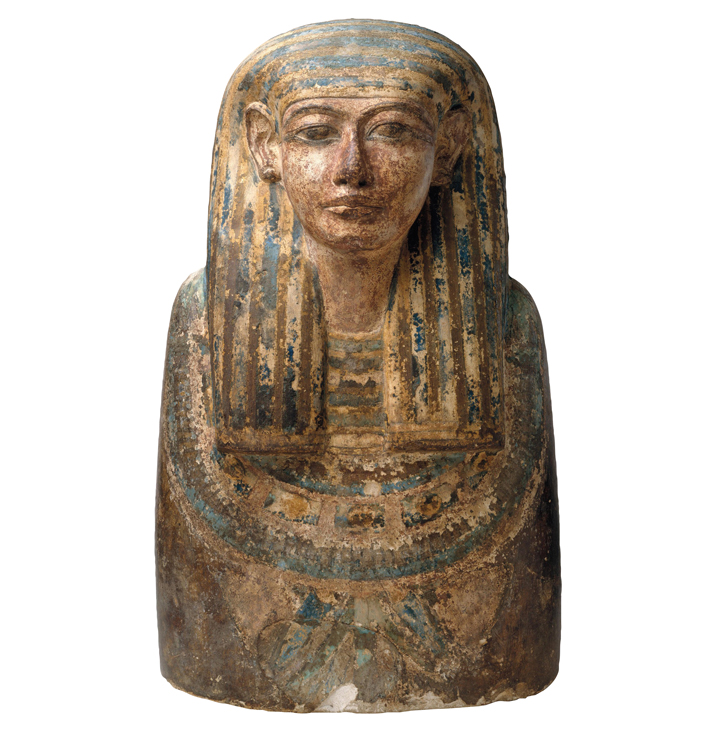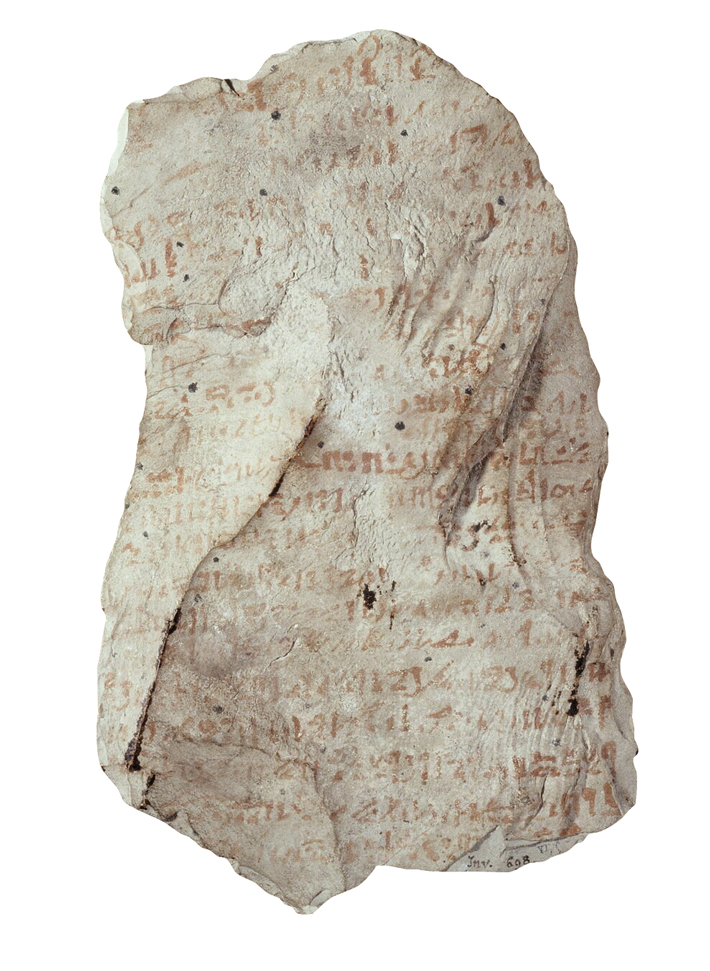Demons
Demon Gate Guardians
Monday, April 25, 2022
 A set of rare depictions of demons guarding a gate was discovered at a Saite Period (688–525 B.C.) tomb at the necropolis of Abusir. Belonging to a general named Menekhibenekau, the tomb also contains an enormous sarcophagus that depicts guardian demons. These creatures are often shown on objects or in tomb decorations standing guard by gates to the afterlife, but images of them acting as physical guardians of a tomb are uncommon. Charles University Egyptologist Renata Landgrafova recently analyzed reliefs that decorate the passage entrance to Menekhibenekau’s tomb chamber. She has found that they depict six gates to the underworld, each guarded by three demons acting as a team watching over the portals that Menekhibenekau has to travel through as he makes his way to the afterlife.
A set of rare depictions of demons guarding a gate was discovered at a Saite Period (688–525 B.C.) tomb at the necropolis of Abusir. Belonging to a general named Menekhibenekau, the tomb also contains an enormous sarcophagus that depicts guardian demons. These creatures are often shown on objects or in tomb decorations standing guard by gates to the afterlife, but images of them acting as physical guardians of a tomb are uncommon. Charles University Egyptologist Renata Landgrafova recently analyzed reliefs that decorate the passage entrance to Menekhibenekau’s tomb chamber. She has found that they depict six gates to the underworld, each guarded by three demons acting as a team watching over the portals that Menekhibenekau has to travel through as he makes his way to the afterlife.
Underworld gate guardians were probably also commonly understood as guardians of the tomb itself. “The fact that the demons are guarding metaphorical gates as well as an actual passage is significant,” says Landgrafova. “This is the only place we have them so obviously serving a dual function.” The demons depicted on the gate to Menekhibenekau’s tomb are the human-animal hybrids common in the Egyptian imagination. One gate is guarded by a turtle-headed demon named “eater of his own excrement,” a lion figure called “he with alert heart,” and a baboon demon known as “great one.” As Menekhibenekau journeyed to the underworld, he would have been required to show himself worthy to pass through these demons’ gates, even as they stood guard over his sarcophagus for eternity.
Ghosts of the Ancestors
Monday, April 25, 2022
 Perhaps the most common Egyptian demons were the ghosts of one’s immediate family members. Often the spirits of the recently deceased were invoked in ritual texts that asked for their blessings—what Egyptologists call “letters to the dead.” These texts were likely read aloud during certain rituals, and were inscribed on bowls or other objects left in tombs. The vast majority of these letters were addressed to the dead men, but Leiden University Egyptologist Renata Schiavo has identified a handful of such letters addressed to women. “These letters are rare,” she says, “but they are important documents that give us a sense that women also played an important role in ancestor worship.”
Perhaps the most common Egyptian demons were the ghosts of one’s immediate family members. Often the spirits of the recently deceased were invoked in ritual texts that asked for their blessings—what Egyptologists call “letters to the dead.” These texts were likely read aloud during certain rituals, and were inscribed on bowls or other objects left in tombs. The vast majority of these letters were addressed to the dead men, but Leiden University Egyptologist Renata Schiavo has identified a handful of such letters addressed to women. “These letters are rare,” she says, “but they are important documents that give us a sense that women also played an important role in ancestor worship.”
One such text Schiavo studied came from the village of Deir el-Medina, the home of artisans who worked in the Valley of the Kings, where pharaohs of the New Kingdom (ca. 1550–1070 B.C.) were buried. The letter was written on a piece of limestone as a rough draft of a text that was perhaps later inscribed on another object. It was written by a scribe named Butehamun and was addressed to the coffin of his dead wife Ikhtay. The text intimates that Butehamun is suffering from some kind of problem that he attributes to the spirit of Ikhtay. He asks the coffin to remind his wife that he has done nothing wrong, that his other deceased relatives still support him, and that she should do so as well.
 Other documents discovered at Deir el-Medina record that Butehamun remarried after Ikhtay died. “It’s reasonable to posit that women were invoked in the so-called letters to the dead in order to appease their anger, perhaps because their husbands remarried, or because these women died in dramatic circumstances, for example during childbirth,” says Schiavo. She notes that other rituals are known that involved exorcizing the malevolent spirits of the dead, but this letter, and others like it, suggests a ritual that was intended to heal the relationship between the living and an angry spirit. Despite having remarried, the senders of these letters may have sought to restore the role of these deceased women as protectors of the household, and to invoke their powers as benevolent demons who could help guide their families, even from the afterlife.
Other documents discovered at Deir el-Medina record that Butehamun remarried after Ikhtay died. “It’s reasonable to posit that women were invoked in the so-called letters to the dead in order to appease their anger, perhaps because their husbands remarried, or because these women died in dramatic circumstances, for example during childbirth,” says Schiavo. She notes that other rituals are known that involved exorcizing the malevolent spirits of the dead, but this letter, and others like it, suggests a ritual that was intended to heal the relationship between the living and an angry spirit. Despite having remarried, the senders of these letters may have sought to restore the role of these deceased women as protectors of the household, and to invoke their powers as benevolent demons who could help guide their families, even from the afterlife.
Advertisement
Advertisement
IN THIS ISSUE
Advertisement

Recent Issues
-
 May/June 2024
May/June 2024
-
 March/April 2024
March/April 2024
-
 January/February 2024
January/February 2024
-
 November/December 2023
November/December 2023
-
 September/October 2023
September/October 2023
-
 July/August 2023
July/August 2023
-
 May/June 2023
May/June 2023
-
 March/April 2023
March/April 2023
-
 January/February 2023
January/February 2023
-
 November/December 2022
November/December 2022
-
 September/October 2022
September/October 2022
-
 July/August 2022
July/August 2022
-
 May/June 2022
May/June 2022
-
 March/April 2022
March/April 2022
-
 January/February 2022
January/February 2022
-
 November/December 2021
November/December 2021
-
 September/October 2021
September/October 2021
-
 July/August 2021
July/August 2021
-
 May/June 2021
May/June 2021
-
 March/April 2021
March/April 2021
-
 January/February 2021
January/February 2021
-
 November/December 2020
November/December 2020
-
 September/October 2020
September/October 2020
-
 July/August 2020
July/August 2020
-
 May/June 2020
May/June 2020
-
 March/April 2020
March/April 2020
-
 January/February 2020
January/February 2020
-
 November/December 2019
November/December 2019
-
 September/October 2019
September/October 2019
-
 July/August 2019
July/August 2019
-
 May/June 2019
May/June 2019
-
 March/April 2019
March/April 2019
-
 January/February 2019
January/February 2019
-
 November/December 2018
November/December 2018
-
 September/October 2018
September/October 2018
-
 July/August 2018
July/August 2018
-
 May/June 2018
May/June 2018
-
 March/April 2018
March/April 2018
-
 January/February 2018
January/February 2018
-
 November/December 2017
November/December 2017
-
 September/October 2017
September/October 2017
-
 July/August 2017
July/August 2017
-
 May/June 2017
May/June 2017
-
 March/April 2017
March/April 2017
-
 January/February 2017
January/February 2017
-
 November/December 2016
November/December 2016
-
 September/October 2016
September/October 2016
-
 July/August 2016
July/August 2016
-
 May/June 2016
May/June 2016
-
 March/April 2016
March/April 2016
-
 January/February 2016
January/February 2016
-
 November/December 2015
November/December 2015
-
 September/October 2015
September/October 2015
-
 July/August 2015
July/August 2015
-
 May/June 2015
May/June 2015
-
 March/April 2015
March/April 2015
-
 January/February 2015
January/February 2015
-
 November/December 2014
November/December 2014
-
 September/October 2014
September/October 2014
-
 July/August 2014
July/August 2014
-
 May/June 2014
May/June 2014
-
 March/April 2014
March/April 2014
-
 January/February 2014
January/February 2014
-
 November/December 2013
November/December 2013
-
 September/October 2013
September/October 2013
-
 July/August 2013
July/August 2013
-
 May/June 2013
May/June 2013
-
 March/April 2013
March/April 2013
-
 January/February 2013
January/February 2013
-
 November/December 2012
November/December 2012
-
 September/October 2012
September/October 2012
-
 July/August 2012
July/August 2012
-
 May/June 2012
May/June 2012
-
 March/April 2012
March/April 2012
-
 January/February 2012
January/February 2012
-
 November/December 2011
November/December 2011
-
 September/October 2011
September/October 2011
-
 July/August 2011
July/August 2011
-
 May/June 2011
May/June 2011
-
 March/April 2011
March/April 2011
-
 January/February 2011
January/February 2011
Advertisement






